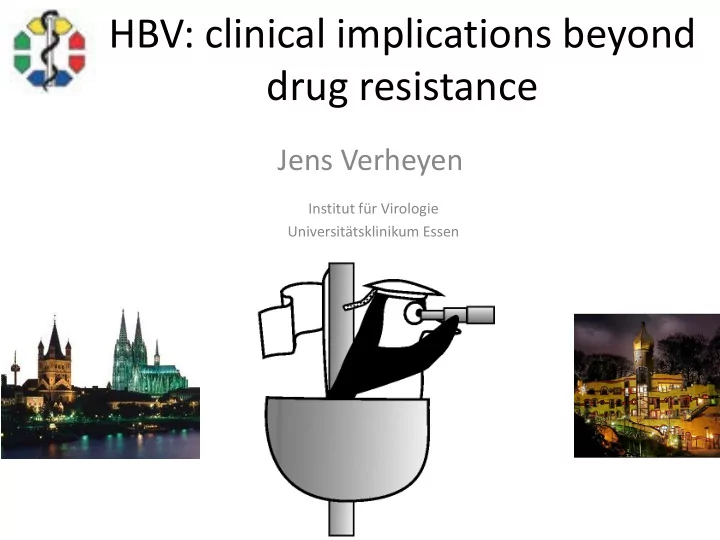

HBV: clinical implications beyond drug resistance Jens Verheyen Institut für Virologie Universitätsklinikum Essen
What can be more interesting than resistance profiles? M204I/V A181T/V N236T T128I V191I Adefovir Lamivudin adefovir A194T V207I lamivudin telbivudin Q215S L229MVFW M204I/V+ Complex L180C/M+ resistance I169T+ profiles T184AGIS+ S202GI+ M250V entecavir
HBV: two overlapping reading frames (RT and HBsAg) RT-mutations HBsAg-mutations
HBV: two overlapping reading frames (RT and HBsAg) RT-mutations HBsAg-mutations stop-codons X X X X
HBV replication Nguyen, T. and Locarnini, S. (2009) Nat. Rev. Gastroenterol. Hepatol. doi:10.1038
Prevalence of stop codons in the HBsAg HBV isolates carrying mutations M204I/V: n=60 Prevalence of HBsAg stop codons: n=7 (12%) Clonal analysis of HBV isolates carrying stop codons (n=7): aditional stop codons n=2 HBV isolates carrying two stop codons: n=2 Mutation A181T does not always lead to a stop codon at position HBsAg 172
HBV: two overlapping reading frames (RT and HBsAg) RT-mutations HBsAg-mutations HBsAg a-determinant
Mutations in the HBsAg a-determinant and immune escape G N S M Q F A P P S T P K T 105L 130D/R C T 109R/V/H/I *131D/I/S T D C C *110M/R/H/I/V 132A/P C T *114R 133I/L/T/V G G145R 117T *134H/N/R/S/V N K 118K/R/S/P 137R/S/W/Y 119R 139S P C C C P 120A/E/LP/Q/S/T/R 140S T V G 121S/Y 141E/I/R C L T 123A/N 142L/R/S P I 124R/Y *143L/P S I P L *126N/S/V/I/T 144A/E/G *127R/S/T 145A/K/L/R T P M I 128V 146D/S T 129H/K/P/R 147S/T G T G A S S W S F * Positions with genotypic specific Q polymorphisms A Y K D Y L L 98- W -163 envelope Schaefer et al., 2004
Frequencies of HBsAg mutations in HBV drug resistance isolates => 22 of 60 (36.7 %) HBV isolates carried HBsAg mutations previously related to immune escape
Impact of HBsAg mutations on quantitative HBsAg assays Differences between two quantitative HBsAg assays in detection in vitro expressed HBsAg Assay A Assay B => Measuring quantitative HBsAg with two different assays might feign quantitative changes
HBsAg mutations and occult HBV infections occult HBV infection: HBsAg (negative) and HBV-DNA (positive) HBsAg mutations correlated with occult HBV infection (Svicher et al.): HBsAg concentration in cell 70 supernatant (IU/mL) 60 50 40 30 20 10 0 HBsAg mutants Architect Elisa Promoter Strep-Tec HBsAg
HBV – clinical aspects acute hepatitis (85%) chronic hepatitis (15%) complications: liver cirrhoses hepatocellular carcinoma
Mutations associated with HCC Mutations accumulating in hepatocellular carcinoma (HCC): (Valentina Svicher / Romina Salpini)
HBV – clinical aspects acute hepatitis (85%) chronic hepatitis (15%) complications: liver cirrhoses hepatocellular carcinoma HBV related immune diseases
Polyarteritis nodosa (PAN): PAN: systemic vasculitis (medium-sized and small muscular arteries) HBV and PAN: 30% (8%) HBV and PAN: acute or chronic HBV infection . HBV-PAN pathophysiology: immune-complex deposits or viral replication
Mutations accumulating in PAN HBV isolates HBV infected patients with polyarteritis nodosa: n=24 GT-A (n=15), GT-D (n=8), HBV GT-E (n=1) Mutations accumulating in HBV PAN isolates: HBV GT-D isolates: n=4 sp-I88V/LHB-I84M/A3105G, sp-H90P/LHB-T87P/A3112C, sp-H100R/LHB-T97A/A3142G HBV isolates: n=12 RT-R41K/SHB-D33N GT-A: n=5, GT-D: n=6, GT-E: n=1
Mutations accumulating in PAN HBV isolates
Looking beyond HBV drug resistance HBV pathogenesis (HBsAg stop codons) HBV immune escape (HBsAg) HBV detection escape HBV: Viral factors and HCC HBV: Viral factors and PAN
Thank you! Institute of Virology, University of Cologne Bastian Beggel MPI for Informatics, Saarbrücken Thomas Lengauer Maria Neumann-Fraune Andreas Erhardt Klinik für Gastroenterologie Hepatologie und Infektiologie Elena Knops Heinrich Heine Universität Düsseldorf Nadine Lübke Eugen Schülter Hauke Niekamp Institut für Medizinische Virologie, Claudia Müller Andreas Geipel Justus-Liebig-Universität Gießen Dörte Hammerschmidt Dieter Glebe Monika Timmen-Wego Saleta Sierra-Aragon Valentina Svicher Department of Experimental Medicine and Surgery Eva Heger Valeria Cento Institut of Virology, University of Rome Tor Vergata Finja Schweitzer Romina Slpini Rolf Kaiser Carlo Perno Herbert Pfister
Recommend
More recommend